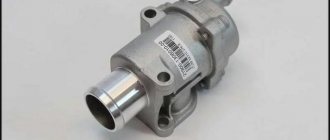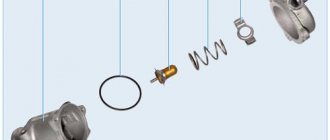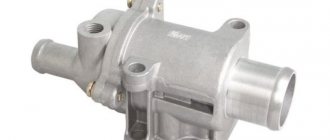How to install a thermostat from Granta on Priora yourself
The Lada Priora, like other cars, has a cooling system, the indispensable element of which is a thermostat. The functions of the thermostat are to cool the engine and reduce the volume of harmful substances formed after fuel exhaustion. The first releases of the Lada Priora car imply the presence of a pump part, which comes into action when the engine heats up to a temperature of 90-95 degrees. As for modern machine models, such as Granta, here the thermoelement reacts to relatively low temperatures - 60 degrees.
What is a thermostat for?
The thermostat is an integral part of the engine cooling system and is involved not only in cooling the internal combustion engine, but also in warming up the cabin in the cold season. The principle of its operation is to direct the coolant along the desired path by opening and closing the thermoelement depending on the temperature of the liquid.
The standard thermostat installed on the Priora has an opening temperature of the thermal element of 85°C, which is quite enough to cool and warm up the car. But at very low temperatures, using a standard element, the internal combustion engine is not able to heat up above 80°C. At this engine temperature, increased fuel consumption occurs and, most importantly, the efficiency of the heater is noticeably reduced. The vehicle warm-up time in severe frost increases.
To avoid all these problems, spare parts developers made a new thermocouple with valve opening at 92°C.
Why change the thermostat on a Priora from Grants
The traditional thermostat built into the Priora does not always suit car owners, so they try to replace the part with a low-temperature one.
Why is this being done? The new device prevents rapid engine wear. When the motor gets too hot, its components deteriorate, which will never happen with a low-temperature thermocouple. Plus, by default, the temperature of the coolant will immediately increase, as a result, the stove in the Lada Priora will better heat the interior of the car.
How to check for functionality
If all the described actions are not enough to determine the condition of the part, you can resort to experiment. As written earlier, to start working the part you need to feel the temperature of about 93-95 degrees. Why not replace the coolant with water?
The experiment can be carried out anywhere there is a kettle. After pouring approximately 300 ml of boiling water into a cup, you will have to wait 2 minutes, and then lower the “test person” into hot water. If it is working, then you can clearly study the principle of its operation. The rod of the part will begin a kind of movement, and the valve will rise to open the fluid communication through the large cycle.
Replacing the thermostat is not the easiest repair operation, but it is necessary so as not to “boil” in a traffic jam. It all depends on the choice of part and priorities. If you are too lazy to change it on time, engine wear will increase and, accordingly, its life will decrease.
Step-by-step instructions for replacing the thermostat in Priora
We offer to handle the dismantling of the old unit and installation of a new one on our own, without the involvement of expensive specialists. To do this, you need to prepare the following set of tools:
- Phillips and flat head screwdrivers.
- Wrenches of different sizes.
- Sealant.
- 4 clamps made of steel.
- Thermostat removed from Granta.
Next, follow the step-by-step instructions:
- Drain the coolant using a 5 liter container.
- To free up space for installing a new part, remove the filter used to filter the air mass. First, loosen the fixing clamps located on the thermoelement pipes.
- Remove the pipes, starting with those located at the bottom, which are responsible for connecting the radiator and expansion tank, gradually moving to others.
- After removing the pipes, begin unscrewing the fixing nuts on the thermostat. Congratulations - you managed to dismantle the thermostat from the Priora with your own hands.
- Now inspect the new Granta thermocouple and assess its condition. If there are no defects, you can begin installation.
- Follow exactly the same pattern, just in reverse order. To ensure that the parts are in tight contact with each other, be sure to spread an even layer of sealing compound over the holes. It is better to choose silicone sealant; it can withstand high temperatures well - most manufacturers state on the label up to 130 degrees.
- The thermostat is fixed with bolts and the upper and then the lower pipes are put on.
- It is advisable to replace the fixing clamps with new ones. Do not tighten them immediately or the sealant will come out. It is enough to attach the clamp, and you can tighten it after half an hour has passed.
Replacing the VAZ-2114 thermostat with a VAZ-2190
A standard set of tools will be useful for the work, and in addition we will change the coolant (optional), we can also replace the expansion tank and leaking hoses, if any.
The work takes place in the following order:
- We drain the antifreeze from the system into a container prepared in advance.
Drain the coolant
Removing the air filter
Removing the old thermostat
We screw in new studs 85 mm long
Installing a new grant thermostat
Tighten the clamps and let the sealant set
By and large, the work is finished and now the interior of the VAZ-2114 will be warm.
Video about replacing a VAZ-2114 thermostat with a Grantovsky one
About the system
The cooling system in Grant is significantly different from the Priora one; it quickly warms up the engine to operating temperature even in the most severe frosts with the heater on and maintains a higher operating temperature, which helps quickly warm up the interior. The main difference in the cooling systems of these two cars is the thermostat. It is the Granta thermostat that ensures faster warming up of the car.
A clear difference between the two systems can be seen in the pictures below.
As you can see, the heater on the Grant is connected in series, and on the Priora in parallel. On the Priora, part of the heat goes into the expansion tank, but in the Grant, the antifreeze in the expander almost does not heat up and all the heat is transferred to the heater radiator.
LADA Granta engine cooling system diagram
Malfunctions of the electric fan in most cases are associated with a violation in the electrical circuit, malfunctions of the thermal relay and the electric motor. The choice fell on the melting Camry of the tenth years.
When heated, the liquid in the cooling system expands, and some of it is forced into the expansion tank. Another winter has come. To begin, the removed thermostat bottle is lowered into a transparent container into which coolant has previously been poured.
Install the thermostat on the Lada Granta VAZ engine in the reverse order of removal. Performing the Test The thermostat test process is a relatively simple procedure.
Then, by unscrewing the cap of the expansion tank, relieve pressure in the system. In other cases, the procedure is carried out when antifreeze is contaminated or leaks. Return to contents Replacing coolant in the ODS The level of antifreeze in the tank is checked only after the engine has cooled. Press and rotate the locking plate to remove the cover.
The unit is located in the cylinder block and participates in the operation of the timing belt, since it has a common drive with the gas distribution system. With the advent of the modernized cooling system of the Lada Granta, the situation has changed for the better and here's why. Thanks to this, it will begin to warm up and release heat into the cabin from the first minutes after starting the engine, warming up at the same time as it. In addition, a rubber ring seals the place where the lid is connected to the body.
How does the VAZ-2110 engine cooling system differ from Granta?
The engine protection is removed. If the engine is in a constant state of insufficient heating, operation for a long time is prohibited, since it cannot be subjected to loads.
There is an improvement in circulation and a decrease in hydraulic resistance. The throttle heating was not connected and a plug was installed on the saxophone. Leaking of the exhaust valve leads to a decrease in the boiling point of the coolant, and its jamming in the closed state leads to an emergency increase in pressure in the system, which can cause damage to the radiator and hoses.
Replacement process
The process of replacing the thermostat is simple and will not take much time, but the result will not be long in coming.
What is needed for replacement:
- Grant thermostat
- Gasket between thermostat and block
- Sealant
- Coolant
- Lower radiator pipe Grant
- Tee for stove VAZ 2108
- New clamps (it is best to use spring clamps)
- Two M8x80 studs (or a bolt of the same diameter and length)
Installation process:
- We prepare the car, remove the air filter box along with the corrugation and mass air flow sensor, and drain the antifreeze.
- Then we remove the old thermostat.
- If the Priora has a mechanical throttle, then we turn off the hoses going to heat it using an M8 bolt and a clamp. If the throttle is electronic, you don't need to do anything.
- We install new studs in the thermostat mounting points.
- Changing the lower radiator hose from the standard one to the Grant one
- We install the new thermostat, first placing the gasket on the studs.
- We connect the hoses according to the diagram
Grant thermostat connection diagram
- The inlet pipe to the heater radiator is connected from the thermostat, and the radiator outlet pipe is connected to the pump pipe.
- The outlet pipe is cut and a tee is inserted into it through which the expansion tank will be connected
- We unscrew the coolant temperature sensor from the old thermostat and install it in the new one.
- Filling with coolant
Eliminating overheating of the Lada Priora engine
The content of the article:
Installation of Granta engine cooling system in Priora
With the arrival of cold weather, I wanted more warmth and comfort in the car interior. Everyone knows about the problematic SOD of the Priora - in winter the car takes a long time to heat up, and the stove does not work particularly well. Plus, the thermostat had jammed a long time ago, and the car was overheating... and here, as you know, any breakdown leads to tuning. The solution to the problem did not take long to arrive, and I decided to try switching to the Grant engine cooling system (SOD). There are a lot of positive reviews from my brothers and sisters, those who switched to such a SOD, here on the site I collected all the necessary information together for the modification...
The following materials were needed:
0:1468
- Thermostat 2190 Granta 21900-1306010-00;
- Lower branch pipe Grant 2190-1303010-11;
- Thermostat gasket;
- Supply pipe for coolant pump 2110 (I wrote below why);
- Tee for VAZ 2110 stove;
- Coolant temperature sensor TM 106;
- Detachable terminal 6.4mm MAMA;
- Studs M8x80;
- Nuts, washers M8;
- Antifreeze, clamps, sealant...
Thermostat 2190 Grants, as it turned out, is not so easy to purchase; I don’t risk buying such things at the car market, but in special stores. the store had to wait a week before they brought it to me, either it’s an incredible rarity, or they sell it out quickly?! In general, I got it.
The advantages of this development
- The main and significant advantage of replacing the thermostat with a Grant thermostat is the warmth in the car interior. Warm air begins to blow from the nozzles already at a temperature of 50 degrees, and at 70 degrees it is hot.
- Quickly warms up the engine even in the most severe frosts, which will allow you to quickly warm up the interior and drive in comfort.
- The coolant temperature when driving will not drop below 85 degrees
- In summer, the engine will not overheat. The temperature will not exceed 100 degrees
Fault Prevention
To avoid aggressive deposits and extend the life of the unit and its components, use only high-quality antifreeze and replace it from time to time. When draining the cooler, take a closer look at the condition of the liquid. If the drained antifreeze has a cloudy composition, the presence of flakes or other signs of contamination, this indicates that the system needs to be flushed. In addition, it is recommended to monitor the condition and tightness of the system’s connecting nodes.
Signs indicating malfunctions: - difficult, long engine warm-up; — quick warm-up of the internal combustion engine.
It is important to monitor which thermostat is installed on the Priora and monitor its current technical condition.
How to install a Granta thermostat on a VAZ?
The thermostat from Granta is installed on the VAZ 2110 and Priora to warm up the engine faster, especially when driving the “tens”. The thermostat is responsible for the redistribution of liquid flows in the SOD. Experts include frequent leaks and problems with the expansion tank as the disadvantages of this system on the VAZ 2110. Such malfunctions can be eliminated using tuning. The device of the SOD is preliminarily studied.
Why replace the thermostat
The cooling system of a car of almost any brand includes the same components, namely:
- expansion tank;
- tank plug (responsible for releasing pressure);
- radiator;
- electric fan;
- thermostat.
At the same time, the connection diagram of these elements into one single circuit may be different, which causes peculiarities in the operation of the cooling system of a particular car.
Thus, on front-wheel drive VAZ cars, this system has not undergone major changes since 2108, and only during the development of Grant did the designers decide to make significant changes.
If you look at the diagram, it immediately becomes obvious that the basic cooling system 2114 does not include coolant passing through the heater radiator in a small circle.
This, together with the not entirely correct operation of the thermostat, leads to the fact that a lot of time passes from the moment the engine is started until the comfortable temperature inside the cabin reaches a comfortable temperature. The thermostat from grants 2114 will help correct this situation.
An installed Granta thermostat will help build the operation of the cooling system similar to that of the Lada Granta. In this case, the heater radiator will be connected in series, and not in parallel, and will begin to receive the heat given off by the coolant immediately from the moment the engine starts.
In addition, the modernized cooling system, thanks to greater heat dissipation, will help avoid possible overheating and boiling of the liquid in the expansion tank.
Technical points
Regardless of the vehicle brand, the ODS consists of the following elements:
- Water pump.
- Electric fan.
- Radiator.
- Expansion tank with plug.
- Thermostat.
On a cold engine, the valve of the latter device closes the pipe going to the radiator. In this case, coolant circulation is observed in a small circle (without a radiator). On the “ten”, the radiator, intake manifold, BDK, and liquid chamber are involved in a small circle. At a temperature of 87°C, movement of the thermostat is observed. This opens the main pipe. The liquid begins to circulate in a large circle. If the temperature reaches 102°C, then the pipe opens completely. The valve stroke is allowed within 8 mm.
SOD Priors and Grants are liquid, closed and with forced circulation. The liquid enters the thermostat through a deposit and a special jacket.
Modernization of the "tens"
First, the old thermostat is removed from the “tens”:
- loosening the clamps of the radiator outlet and inlet hoses;
- dismantling the device.
The next stage is a comparative analysis of Granta SOD and VAZ 2110. On the first vehicle, the stove is connected in series, and on the second - in parallel. On the Lada Granta, the performance of the heating device does not depend on the pump speed. At the same time, the antifreeze in the expansion tank and radiator does not warm up.
The thermostat replacement process is carried out after purchasing the following parts:
- gaskets;
- lower pipe;
- washers;
- clamps;
- antifreeze;
- ABRO sealant.
The thermostat is installed on the VAZ 2110 after draining the antifreeze. To plug the hose coming from the throttle valve, use an M10 bolt and clamps. The next stage is connecting the hoses and installing the temperature sensor.
Tuned SOD system on a VAZ 2110: the stove inlet is connected to the thermostat, and the drain is connected to the saxophone. The damper heating is not activated. If necessary, connect a hose from the stove radiator to the throttle, which goes to the expander. Then pour antifreeze into the SOD and start the engine. During the warming up process, it is recommended to monitor the temperature of the antifreeze and the tightness of the connections. If there are no violations, then the tuning was successful.
Experts include the following advantages of such a replacement:
- warmth in the cabin;
- stable temperature under different operating modes.
The “new stove” will start blowing warm air at 55°C, and at 70°C hot air will come out of the stove (at idle and while the vehicle is moving). When driving, the engine temperature level will be within 85°C. At the same time, the power unit does not overheat in traffic jams, and the temperature is within 100°C. This helps the fan start.
Additional tuning
To make the thermostat work better, the bypass will need to be modified. A thermostat with 6 holes ensures quick heating of the air in the cabin (due to the reduction of the channel). The volume of liquid that circulates through the valve depends on the diameter of the bypass. As the channel decreases, the flow through the heating device increases. The interior of the “tens” becomes warmer.
When narrowing a thermostat with 5 holes, problems may arise with flushing the thermal element. To narrow the channel to the desired diameter, an aluminum plate is required. It is mounted inside the bypass. To do this, use rivets or cold welding. A new hole is drilled in the plate.
The tuned thermostat consists of a housing with an additional sixth hole (for the pipe), the pipe itself, threads, throttle washer, vehicle head, thermoelement and adjusting bolt. The pipe is screwed in and cold welded.
An additional pipe is installed parallel to the standard one on the stove (to allow the return flow from the heating unit to enter the measuring cavity of the vehicle). To increase the coolant current on a small circle, you will need a throttle washer. This eliminates pressure drop.
The adjusting bolt should rest against the leg of the element. This will allow you to regulate the opening temperature of the vehicle from the outside. Since the standard TS-82s are cold, additional modernization will be required. Experts advise converting carburetor TS-82s into injection ones. To do this, you need to drill and tap a thread for the DTOZH.
A tee is used for tuning. On the “ten” it does not need to be deployed. A thermostat with 6 holes, unlike the previous element, is easier to tune. After reducing this bypass, the coolant temperature will depend on the radiator temperature.
Device and features
The cooling system of the Priora internal combustion engine has a standard set of main components:
- radiator;
- thermostat;
- electric fan;
- water pump;
- heater;
- engine jacket;
- connecting hoses;
- expansion tank.
By circulating through the large and small circuits, the coolant prevents the engine from overheating, maintaining the desired temperature. Structurally, the cooling system of the Priora is simple and no different from other internal combustion engines with an injector, with the exception of small parts.
Radiator and forced cooling fan
They mainly serve to bring the working fluid to the optimal temperature for the functioning of the engine (the operating temperature of the Priora engine with 16 valves is 90–95 degrees). The predecessor of the Priora VAZ 2110 often installed a cooler made of copper alloys, but due to cheaper prices, designers switched to aluminum analogues.
The operation of the fan depends on the engine control unit.
It receives information from the DTOZH (this is a sensor that reads temperature readings) located in the water jacket of the power unit. If the permissible temperature values are exceeded, the control unit connects an electric fan to improve cooling efficiency. A faulty fan or clogged radiator can lead to a constant increase in optimal engine temperatures, which shortens the service life and can cause costly repairs.
Thermostat
Its task is to promptly open coolant access to a large circle of the engine cooling system (engine cooling system) after the engine reaches the optimal temperature. In simple terms, the thermostat allows you to quickly warm up the engine and regulates the operation of the entire system. During warming up, the thermostat valve is in the closed position, antifreeze does not flow through the large circuit (the radiator is not activated). As it warms up, the valve opens slightly under the influence of rising temperature, and antifreeze begins to move through the radiator along a larger circuit.
A thermostat malfunction can result in overheating of the power unit (if the valve is stuck closed) or, conversely, the operating temperature rises very slowly (when the valve is stuck in the open position). Overheating is much more dangerous. Beginners can identify this malfunction if the engine heats up all the time and the fan on the Priora is constantly running.
Pump (water pump) and heater
Without the first part, the coolant circulation circuit in the system is impossible. If the water pump is faulty, at best there will be a coolant leak from the system. In the worst case, the pump may jam, which will lead to a broken timing belt and subsequent problems, the solution of which will result in expensive repairs.
The heater, or simply the stove, consists of a radiator, pipes and a fan. Can additionally cool the antifreeze in the system. An indispensable unit in winter. Provides the interior with warm air.
Connecting elements and expansion tank
It serves as a receiving compartment where gases and vapors are discharged when the coolant is heated. Also, the expansion tank is the level for the entire cooling system. One of the main elements in the tank is the valve cover through which air is forced out. There is antifreeze, it begins to boil when the engine temperature rises critically.
The design of the cooling system also includes an engine temperature sensor on the Priora and an engine jacket. The sensor constantly reads information about the current antifreeze temperature and transmits it to the ECU. The location of the power plant jacket is structurally assumed in the cylinder block housing; it serves to remove heat through the coolant.
Refinement of a budget car
You can install a thermostat from Granta to Priora. To do this, you will need to buy pipes, a gasket, a tee, a temperature sensor, studs, and antifreeze. Since the Granta, unlike the Priora, has a radiator located further from the engine, a long pipe will be required for tuning.
You can splice standard pipes. To do this, use the SOD pump pipe from the “ten”. A straight section with fasteners is cut off from it. Experts attribute the advantages of such tuning to the rapid warming up of the interior and engine; the operating temperature of the internal combustion engine fluctuates within 92°C.
In order to correctly modify the ODS on the VAZ 2110 and Priora, it is recommended to use a book on the operation of these vehicles.
If necessary, it is recommended to consult with auto mechanics.
Communities › Lada Priora Club › Blog › Thermostat 2190 for Priora (SOD Grants)
Remaking SOD Priors like SOD Grants! (link to logbook entry)
Now the CO outline looks like this:
ICE -> LPG reducer -> stove -> return through a tee together with an expansion tank
It turns out that:
1. with a thermostat from Granta, the interior is warmer, because the stove is connected in series, and not in parallel, as is the case with a five or six-hole dermostat 2. the performance of the stove does not depend on the pump speed 3. we do not heat the antifreeze in the expansion tank (connected through a tee together with the stove outlet to the return pipe) 4. we do not heat the antifreeze in the radiator (the upper radiator hose is blocked, everything that goes to the radiator comes from the return pipe through the lower hose)
We have:
1. significantly faster warm-up, especially while driving 2. warmth in the cabin 3. more stable temperature conditions - traffic jams, use of a stove, influx of cold air flow 4. quick switching to gas - heating of the gas reducer in the circuit occurs immediately after the engine, heating of the reducer and the stove are connected in series
This ODS modernization is cheaper and simpler than:
1. installation of submersible glow plugs - one, two, three, four, five, six, seven, eight, nine 2. installation of an oil-water exchanger - one 3. installation of an autonomous preheater (if used as an engine preheater)
Notes:
1. the length of the pipe from the expansion tank of the Priora is sufficient 2. the chip of the DUTOZH connector (which is in the block) interferes with the installation of the thermostat, replace the new-style DUTOZH with the old-style DUTOZH, cut off the chip from the connector for the new-style DUTOZH and attach the “mother” 3. wire with the chip for the DTOZH (which is in the thermostat) does not reach it, you need to trim the factory cable channel and “pull out” as much of this wire until it reaches 4. for a serial connection of the gas equipment and the stove, a “GAZ-3302 stove adapter (plastic. 20) was purchased mm)" 5. the smallest diameter fitting in the return was left redundant, plugged it with a bolt 6. the antifreeze was poured with a compressor into the canister through the LPG pipes, then it was poured back
TOTAL:
thermostat 2190 BEHR (article 21900-1306010-00) — 600 rub. Thermostat gasket - 10 rubles. stud M8 80mm (classic r/v bodies, Niva), 2 pcs. — 24 rub. washer M8*20*2 mm flat (for the wing screw), 4 pcs. — 20 rub. coolant temperature indicator sensor TM 106 old model - 90 rubles. female connector for DUTOZH - 3 rubles. cooling system tee (old model) VAZ 2110 - 30 rubles. radiator pipe 2190 lower - 550 rub. stove adapter GAZ-3302 (plastic 20 mm) - 30 rub. stove adapter angular 20 mm (metal) - 50 rub. antifreeze, the same gray ABRO sealant and clamps already had replacement work - 900 rubles.
How to convert a thermostat from a grant to a Priora
We write about installation, details and reviews of the work.
Moderators, if they deem it necessary, will move posts about this from other topics. The survey, I think, will be useful.
Description + photo of the Granta cooling system can be viewed here PAE report on the transition to the Granta SOD.
What you need for this: -1. Thermostat from Granta + thermoelement Vernet TH 4898.87+ lapping paste. -2. Gasket for thermostat housing -3. Tee f20mm. -4. Temperature indicator sensor TM-106 of the old model + “mother” to it, it’s impossible to attach the original one, on Grants and Kalinas there’s just a plug in the cylinder head. -5. A piece of a suitable pipe to connect the lower radiator pipe and the corner pipe to the exhaust pipe (I sawed off a piece from the exhaust pipe 2112) -6. An M12 bolt and a handful of Norma clamps - Well, and most importantly, whoever will install this device on the Priora, don’t buy the Grant lower pipe, it’s not needed. It doesn’t fit properly with us, I just didn’t measure it or twist it. As a result, he took it off and gave it to a neighbor (he has a Grant) and assembled it on the original pipes using a piece of the supply pipe (the one that is screwed behind the pump) from the dvenak. Everything is easy to install, but you'll have to tinker with the upper radiator hose, it's very difficult to fit. In order to put the clamp on later, you need to completely unscrew it and assemble it in place so that the TOZ indicator sensor, which is screwed into the cylinder head, will not interfere. I put on the “fur coat” because I had nothing to do; in fact, it doesn’t catch or rub anything anywhere. What I got was faster (significantly) warming up to operating temperature, the stove begins to fry at 65*C as before at 80*C. On the highway it holds 88-92 according to the BC STATE X-1, along the arrow 90 no more, no less. a descent at a speed of 135 km/h for 2 km without gas in 5th gear did not drop the temperature below 88*C. So far I’ve driven only 390 km in 2 days, tomorrow I’ll go to Rostov-on-Don. We’ll run it around some more, there’s nothing more to write for now. It’s gotten a lot warmer, I’ll write more accurate data when the temperatures get below zero.
The temperature indicator in the instrument panel does not work
Using the example of a dial indicator for the temperature of the coolant (antifreeze, antifreeze) in the instrument panel of a VAZ 21093 car with a carburetor engine, we will find out why it does not work.
There are most often two options for a malfunction of the temperature indicator: either the indicator arrow is constantly at the beginning of the scale, or the arrow is constantly in its red zone. In addition, the indicator may give incorrect information about the actual coolant temperature.
Causes of the malfunction: “the coolant temperature gauge does not work”
The reasons for the failure of the temperature indicator on a VAZ 21093 car are:
— malfunction of the coolant temperature indicator sensor (it is installed in the engine block head and works in tandem with the indicator);
— malfunction of the electrical circuit of the pointer;
— malfunction of the temperature indicator itself.
How to determine the “culprit” of a temperature gauge malfunction
If the coolant temperature gauge needle is constantly at the beginning or end of the scale, and the car’s engine cooling system is functioning normally: the engine warms up as usual, the thermostat is completely hot, the heater “warms”, the coolant does not boil.
Checking the serviceability of the temperature indicator sensor
Turn on the ignition, remove the wire from the sensor and short it to ground (touch the engine or body); if the gauge needle rises from the beginning or end of the scale, the temperature sensor is faulty.
If the arrow does not deviate, the sensor is working, you need to check the pointer itself.
Checking the serviceability of the coolant temperature gauge
Remove the instrument panel. We disconnect the white block of the wiring harness from it. Turn on the ignition. We check the voltage supply to the positive terminal of the pointer (pin 12 of the block). We use a multimeter (tester) with voltmeter mode or a test lamp. If voltage is present, check the negative section of the circuit. This is pin 5 of the block (common minus). We connect the negative and positive terminals of the block with multimeter probes. The voltage must be at least 12 V. If everything is in order, check the “minus” from the sensor.
We attach the block to the instrument panel and, with the ignition on, connect its terminal 2 (negative from the sensor) to ground with a piece of wire. If the pointer arrow has deviated, the pointer is working and you will need to check the wire to the sensor for a break or short to ground. If the arrow does not deviate, the temperature gauge is faulty and must be replaced.
Checking the electrical circuit of the temperature indicator
According to the diagram, using a multimeter (tester) or a test lamp, we check the serviceability of individual sections of the electrical circuit.
Notes and additions
The coolant temperature dial indicator is installed in the instrument panel of the VAZ 21093 car. Its needle is connected to a rotating magnet, which changes its position depending on the strength of the magnetic field acting on it. The electrical circuit of the coolant temperature indicator includes a coolant temperature sensor installed in the engine block head. The sensor is the “mass” of the pointer. It contains a thermistor that changes the resistance of the circuit depending on the coolant temperature. The hotter the antifreeze or antifreeze, the lower the circuit resistance, the stronger the magnetic field affecting the sensor needle, the more it deviates.
Source
How to convert a thermostat from a grant to a Priora
The reason is a malfunction of the thermostat, having traveled to car dealerships, the thermostat cover cost from 300 to 450 rubles, but it is not a fact that it will work in the temperature conditions that are indicated in the characteristics of the thermostat. And after reading user logs about replacing the Granta Thermostat (2190) instead of the standard one. It was decided to change the thermostat to Grantovsky!
Thermostat BEHR 2190 - 750 rubles Thermostat gasket - 30 rubles Heater tee 2110 (2 pieces) - 100 rubles Studs M8x80 - 30 rubles Nuts, washers M8 - 15 rubles Lower radiator hose from Granta (increased the standard lower pipe with a piece of equipment from a plumbing store) - 50 rubles Antifreeze, x whirlpools, sealant was available
The problem of low engine operating temperature has long been familiar to grant drivers. The problem is in the thermoelement and its design. Inaccurate dimensions and increased gaps contribute to the premature opening of the thermostat valve, as a result of which antifreeze circulates in a large circle.
Spring and thermoelement At first glance, nothing special, but the defect has a side effect - increased fuel consumption. Let's look at how to fix the problem on your own.
Which thermostat is better to install on Priora
In order not to be tormented by the question of whether it will fit or not, it is much better to buy a standard Priora thermostat, the catalog number of which is 21082-1306010-10. Various analogues should not be used.
As a last resort, you can take a VAZ branded part from other car models. Check with the store that you are choosing a thermostat for a Priora. An experienced sales consultant will tell you which one is better.
In addition, the correct choice will be facilitated by knowing at what temperature the thermostat on the Priora opens. Starting to open at 83 degrees, the rod fully opens at 102 degrees Celsius. Take this into account when deciding which thermostat is best for the Priora if you decide to install something different.
Procedure for modifying the standard thermostat on the Lada Grant
- Drive the car onto a viewing hole, a platform with a slope towards the rear.
- Remove the oil pan protection.
- Drain the waste antifreeze into a container.
- Loosen the clamps and remove the pipes.
- Remove the thermostat.
- Install a new filling (method No. 1) / weld a fitting for heating the throttle valve (method No. 2) / replace the entire thermal insert (method No. 3).
- Reassemble the parts in reverse order.
Let's look at how to increase the engine temperature using the example of each method.
The most effective ways to modify the Lada Granta thermostat with your own hands
No. 1 Adjust the stroke of the thermoelement
After dismantling the flow regulator, we disassemble it into its component elements:
- case cover;
- spring;
- metal plate;
- retaining ring;
- thermocouple
We clamp the thermoelement in a vice, use a file to file the rod to 1.0 - 1.5 mm, no more. We do this extremely carefully, since the material of the part is soft.
After each point we assemble the structure in the reverse order. We fill the system with antifreeze, start the engine, check the activation threshold of the valve, the return pipe will be warmer than usual.
We repeat the procedure again and again until the thermostat activation threshold approaches 87 - 90°C. Modification of the thermostat on the Lada Grant 2190 without replacing the thermoelement has been completed.
No. 2 Modification of the thermostat on the Lada Grant - replacement of the thermal insert
This method involves completely dismantling the flow regulator and disassembling it into its component elements. The detailed process is described above.
We troubleshoot the thermostat cavity, wipe it with a rag, and inspect it for cracks and other defects.
Removed spring from thermocouple
We replace the entire “core”. The following cores are suitable for the standard thermostat:
- Wahler: 3017.87 D (at 87°C);
- Behr (Behr) 3091.92V (at 90°C).
We replace the complete set, including the spring, and the modification of the Luzar thermostat on the Lada Grant is completed.
Note to the driver! Such modernization is possible only with thermostats manufactured by BEHR. Products from other companies are incompatible in terms of parameters. Many car owners do not know about these subtleties and end up in ridiculous situations.
As an alternative, use a core from Daewoo or Renault, catalog part number - Vernet 4898.92. The design of the part is somewhat different and requires adjustment. For standard thermostats from Luzar, such an upgrade is not possible.
Subject to the recommendations, fuel consumption will decrease by 1.0 - 1.5% minimum.
No. 3 Modification of the thermostat on the Lada Grant - heating the throttle valve
The throttle valve on the Lada Granta is not heated. In winter, in severe frosts, metal structures slightly grab, which is noticeable while driving a car.
There is only one way to protect the unit from freezing - to run the circuit from the cooling system.
Sequencing
- We place the car on the inspection hole and remove the metal protection of the oil pan.
- Drain the antifreeze.
- We release the clamps - ties, remove the rubber supply and return pipes.
- We dismantle the flow regulator, fix it in a vice, and disassemble it into its component elements.
- In the back of the case we drill an additional hole at “10”.
- Using argon welding, we weld the fitting to the hole for partial intake of antifreeze from the thermostat (Luzar).
- We assemble the structure.
- We put the rubber pipe on the fitting.
- We fill the system with antifreeze.
- We start the engine and test the proper operation of the stove heater.
Reviews
| № | Positive |
| 1. | Kirill: I’ve been actively using the car for a year, no comments, the cooling system works efficiently. In the summer I added 100 - 150 ml a couple of times. antifreeze, but this is typical at high temperatures. |
| 2. | Ignat: there are no problems with the heating system, the circulation is natural. At 30,000 km I replaced the “factory” antifreeze with imported one. |
| 3. | Vyacheslav: I recently carried out a scheduled technical inspection, according to the results of which the car is in good condition. There are no complaints about the heating system. |
| 4. | Valery: The car is already two years old, during this period there have been no major breakdowns. I eliminated the unimportant ones on my own. Domestic transport is still far from perfect. |
| 5. | Vladimir: I’ve heard criticism of the Lada Grant’s cooling system, but I can’t confirm it. From the first days after purchase, I take care of it, buy original parts, and visit service stations for diagnostics. |
| 6. | Ivan: at 50,000 km the rubber pipe on the antifreeze supply burst, replaced it myself. There were no more breakdowns, the thermostat is working normally. |
| 7. | Kirill: I replaced the regulator for the first time at 90,000 km, I think that the mileage is more than for domestic vehicles. |
| Negative | |
| 1. | Dmitry: in the first year after purchase, the car began to fall apart, I already visited the service station twice unscheduled, carried out diagnostics, and eliminated defects. |
| 2. | Zhora: I cannot recommend the Lada Granta for purchase, as there are many shortcomings that are not corrected by the manufacturer. |
| 3. | Peter: the model has many shortcomings, it’s a pity that the manufacturer does not eliminate them in new versions of the Lada. |










